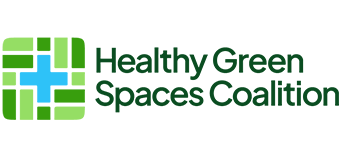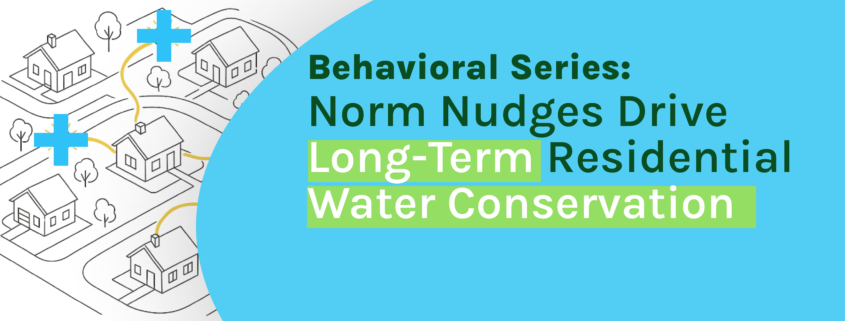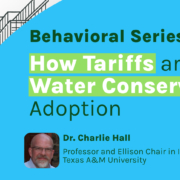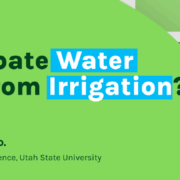How Norm Nudges Drive Long-Term Water Conservation
Executive Editor: Steve Whitesell
Author: Kevin Rowe
Comparing neighbors may be the most powerful drought-fighting tool you’ve never used.
Key Takeaways
A wave of real-world international conservation program studies from Georgia, Colombia and Chile, show that social norms don’t just change behavior at the individual level:
- In Georgia, neighbor comparison letters cut household water use by ~5%, especially among high users, and the effects were persistent for up to 7 years.
- A three-city U.S. trial found that recipients of social norm reports were more likely to join additional utility conservation programs.
- In Colombia, neighborhoods saturated with norm-based water reports saw untreated households reduce their use too — evidence of peer-to-peer spillover.
- In Chile, a conservation nudge led to a surprising bonus: a 9% drop in electricity use among already-efficient homes — a cross-resource spillover.
Across all cases, the biggest gains came when messages were frequent, socially anchored, and publicly visible.
A norm nudge is a behavioral science technique that encourages behavioral change by showing people what others are doing — especially what’s considered typical or socially approved in their community.
As an example, a utility can send a letter to residential water users saying, “Your household used 20% more water than your neighbors last month. Most homes in your area are using less than yours.”
Water Conservation Goes Viral — Without Rebates
Behavioral science studies show that social norms like peer comparisons can cut household water use, trigger positive spillover into other conservation habits, and spread organically throughout neighborhoods.
Why It Matters
As droughts and water scarcity intensify, utilities need low-cost, scalable strategies to reduce residential water use.
With limited conservation budgets being able to get one rebate to drive actions across several homes in just one neighborhood can pay dividends. This way, water conservation managers can maximize savings with limited budgets and other resource constraints.
Norm-based messages — simple comparisons of household water use to neighbors — consistently deliver real savings without relying on financial incentives. One powerful tactic is providing homeowners with feedback on their water use compared to others (neighbor comparisons), leveraging social norms to prompt conservation.
Social Comparison Study in Georgia
A randomized trial with 100,000+ households in Cobb County, GA found that sending households letters about their water usage relative to their neighbors led to significant savings.
On average, these “social comparison” messages cut water consumption by around 5%, with the largest reductions (> 5% savings) observed among high-use households.
Importantly, the norm-based approach had lasting effects: while a simple pro-environmental appeal produced only short-term changes, the social comparison letters caused a persistent drop in water demand well beyond the initial intervention.
In other words, only the messages augmented with peer usage norms created durable and lasting conservation behavior.
Multi-Utility Study
A multi-utility study of three random controlled trials in the U.S. confirmed ~5% average savings from mailed home water use reports with neighborhood comparisons, though results varied by locale.
Notably, these norm-based interventions can produce positive spillover effects rather than “crowding out” other actions.
In fact, households who received social comparison reports were more likely to participate in other water-saving programs offered by the utility (e.g. audits or device retrofits) compared to control groups.
This indicates a “crowding in” effect: norm nudges not only directly reduce usage, they also spur greater engagement in conservation behaviors beyond the initial ask.
Colombia Social Study
Researchers have also explored whether normative feedback can spread or “go viral” within communities. A recent experiment in Colombia tested a two-stage saturation design: some neighborhoods had a high percentage of households receive water-use report cards while others had few or none.
The study found that accounting for spillovers dramatically increased the estimated impact of the norm campaign – untreated households in high-saturation areas also reduced their consumption, presumably via information diffusion and peer influence. More frequent feedback amplified the effect (monthly reports were more effective than bi-monthly).
These findings suggest that norm-based messages can propagate behavior change through social networks, magnifying total savings beyond the directly targeted homes.
Chile and the Cross-Utility Spillover Effect
Evidence of cross-domain spillover has emerged as well. In an experimental campaign in Chile, utility customers received social information encouraging water conservation.
In addition to a ~6% reduction in water use among the treated group, researchers observed a significant drop in electricity consumption (~9%) among households that were already efficient water users (efdinitiative.org).
In other words, conserving water appeared to influence people to save energy too – a positive spillover possibly driven by cognitive consistency or heightened environmental awareness.
This novel result illustrates how a nudge in one resource domain can trigger broader pro-environmental behavior changes.
What’s Next
Utilities should consider scaling up personalized water reports, exploring community-level feedback, and integrating social recognition or “leaderboard” strategies to further amplify the social spread of conservation behavior.
Resources
https://www.journals.uchicago.edu/doi/10.1086/683427?utm_source=chatgpt.com
https://papers.ssrn.com/sol3/papers.cfm?abstract_id=4326214
https://ideas.repec.org/a/ucp/jaerec/doi10.1086-683427.html
https://www.aeaweb.org/articles?id=10.1257/aer.101.3.318
https://papers.ssrn.com/sol3/papers.cfm?abstract_id=4326214
https://www.efdinitiative.org/publications/behavioral-spillover-effects-social-information-campaign















